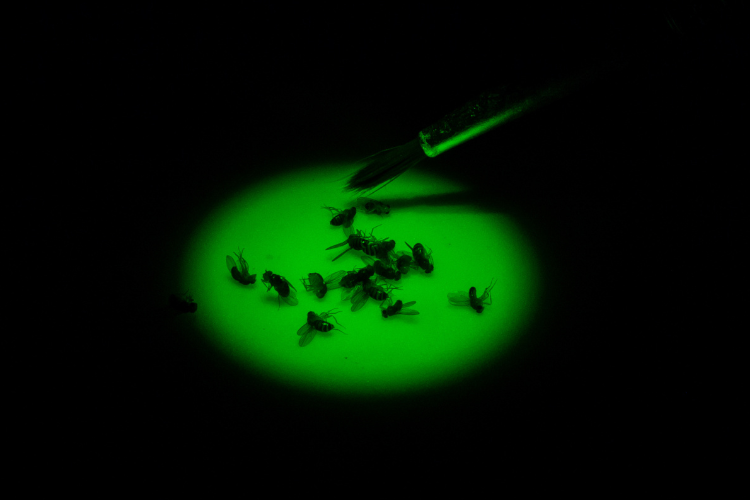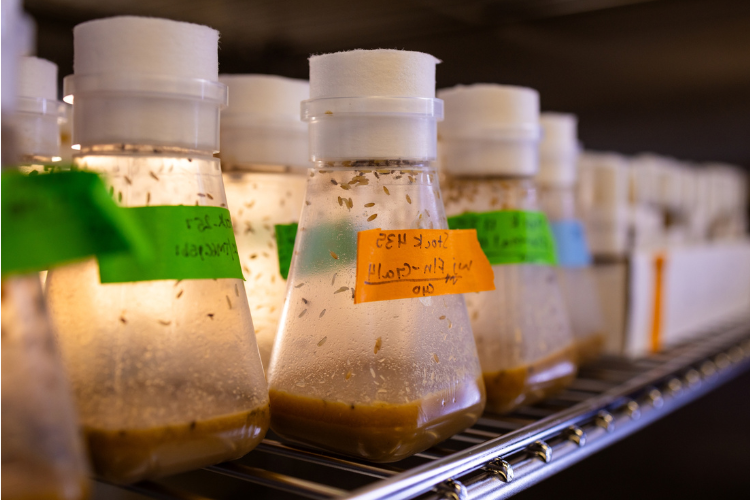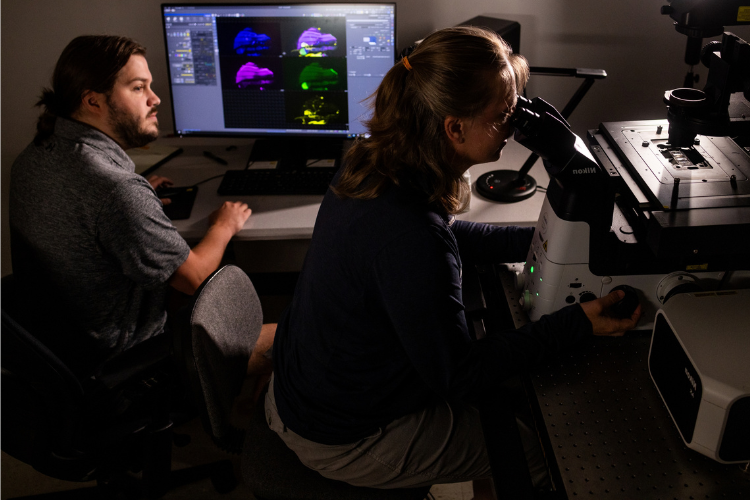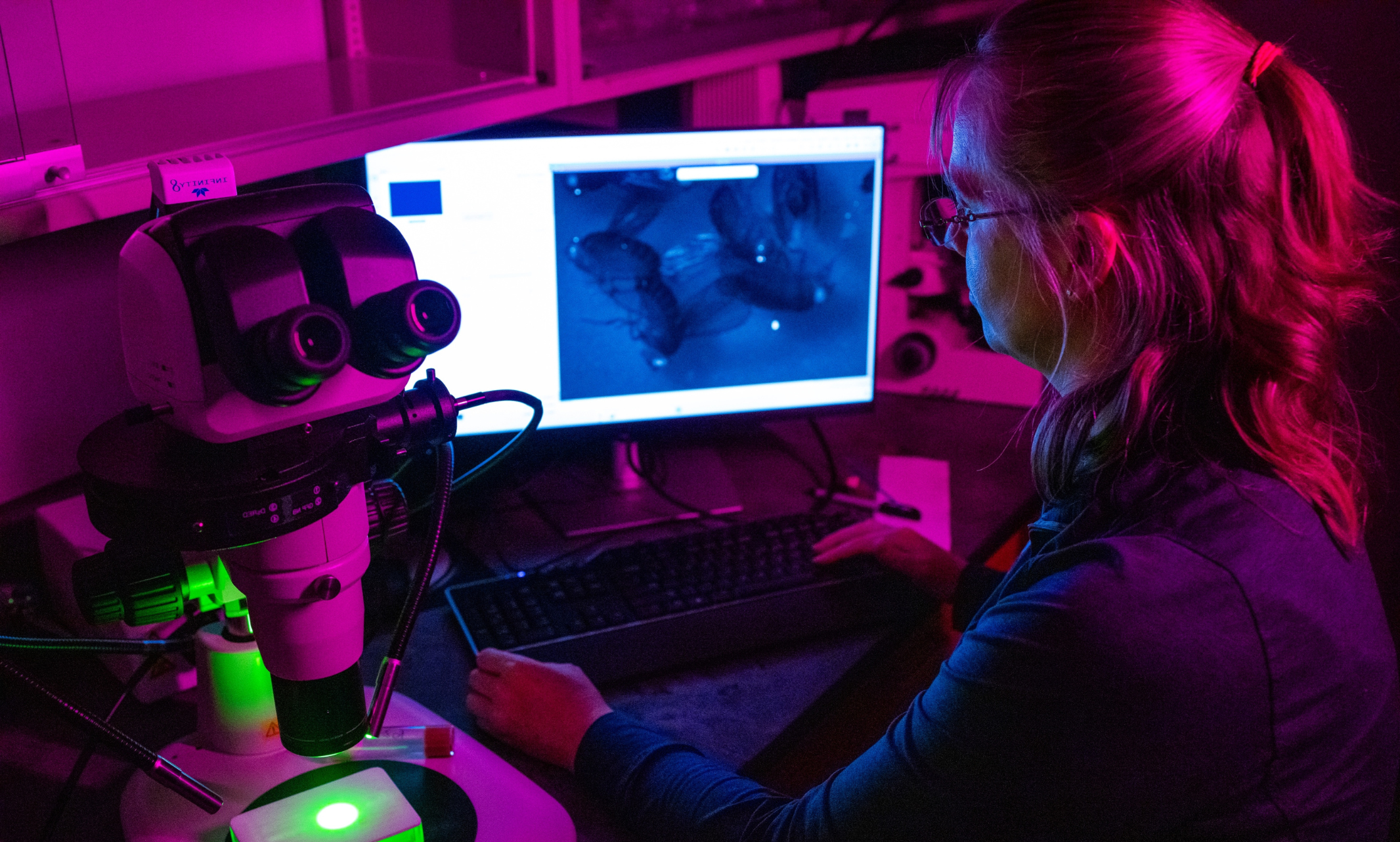Talk about significant research. UMKC助理教授Maria Spletter的生物实验室正在研究导致癌症和心脏病等慢性疾病的体内蛋白质的分解. She has lasered in on myotonic dystrophy — or loss of muscle function.
Myotonic dystrophy is among the most common rare diseases, estimated to affect 1 in 2,100 births. 由于核糖核酸(存在于所有活细胞中,也被称为“RNA”)的调节改变和改变了肌肉的控制,这种肌肉疾病也会导致加速衰老, growth and contraction.
spleter选择了一个在大小上不重要但在效率上很重要的模型:果蝇.

Why Drosophila?
“Drosophila are a very powerful genetic model,” Spletter said. “这意味着在苍蝇身上有很多可用的工具,使我们能够做在小鼠、大鼠或人类身上不可能做的实验. Plus, Drosophila grow quickly from an egg to adult fly in 10 days, so you can follow each step during development in a matter of weeks instead of years.”
Another benefit of using Drosophila is the muscles it has are highly conserved, meaning the proteins that build muscles, 苍蝇和人类的肌肉是如何收缩的,肌肉的结构和组织是一样的. In fact, models of human disease in flies reveal the same mechanism and same muscle type. These flies, therefore, 提供一个有用的模型来理解由致病突变引起的肌肉的基本机制和缺陷, so that further studies in human cells can be targeted.
这意味着研究小组可以研究导致肌肉纤维丢失或损伤的发育机制,而这在哺乳动物身上是不可能进行详细研究的. By tracking the initial stages of muscle fiber during development, they can tell exactly which steps in the assembly process are defective. 对小鼠或大鼠的研究通常没有这种水平的分辨率,也没有详细关注肌肉结构是如何被破坏的.

Testing With High-Powered Tools
“We test muscle function to measure how well flies can fly, jump, climb, 在仰面摔倒后把自己翻过来,在涂上荧光粉后,它们能多快地清洁自己,” Spletter said. “所有这些都让我们了解了活苍蝇的行为,当涉及到它们的肌肉工作情况时.”
To investigate the function of these RNA-binding proteins on the cellular level, 实验室用荧光标记标记肌肉的尖端,并用显微镜观察肌肉的运动. They then quantify the movement by measuring how often the muscles contract, how much they move when they contract and the dynamics of the contraction. This is where contraction is usually impaired and irregular in mutant flies.
然后,研究人员使用高倍显微镜,利用激光对样品成像,观察染色的肌肉,并标记不同的成分. Unlike a traditional microscope, 激光使我们能够成像1微米或更小厚度的单一平面(果蝇大约1毫米厚), and there are 1,000 microns in 1 millimeter). An indirect flight muscle cell is around 100 microns thick, 因此,至少可以拍摄100张肌肉不同平面的照片,以查看其内部的所有结构.
With the lab’s microscope having four different lasers, 可以同时查看细胞的四个不同组成部分,以查看它们相对于彼此的位置. With the mutants in particular, the team can observe how their localization has changed. 这样就可以比较突变果蝇和对照果蝇,看看在细胞结构水平上突变果蝇的结构是如何不同的.
然后,研究小组从对照组和突变果蝇身上提取组织样本,进行分子和生化测试,以找出突变肌肉的基因变化, subsequently linking molecular defects to changes in cellular structure as well as muscle function.
This is usually when mRNA-Seq, a combination of a biochemistry and bioinformatics approach, takes place. 从果蝇中分离出mRNA(在细胞中转化为蛋白质的编码蓝图),实验室对肌肉细胞中表达的每个基因和基因变体进行测序. Typically, there are around 6,000 to 8,000 genes expressed at any time, and if you look across development, around 10,000 genes change expression. The data is usually viewed for individual genes, individual splice events within one gene, or globally at all the changes in gene expression and splicing. 获得的不同水平的数据使实验室能够在系统水平上了解与对照相比,突变肌肉细胞发生了什么变化, 并在个体基因水平上识别可能解释我们所看到的特定表现型的目标.
Spletter’s lab also conducts mass spectrometry, 用于测量样品中一个或多个分子的质荷比的一种分析工具, 从肌肉细胞中分离出蛋白质,并确定肌肉中存在的大多数蛋白质的身份. Around 4,000 proteins are typically detected, but more sensitive machines can see up to 6,000 proteins. 这种分析方法提供了在我们的突变肌肉中哪些蛋白质发生变化的信息,并允许从mRNA-Seq数据中比较RNA中的蛋白质变化,并准确地找出RNA调节的变化如何导致肌肉纤维和结构的缺陷.

The Discoveries
Recent research findings from Spletter’s lab, which were published on bioRxiv, revealed how the characteristics in mutant muscle are a domino effect. 在肌肉发育的每一步中出现的小问题都会导致并进一步加剧对肌肉的影响. This leads to greater disruption on the muscle, compared to when Bruno1 mutant is added to the later part of muscle development.
From the same research findings, spleter的实验室发现了在苍蝇身上测试基因治疗策略的潜在可能性,这些策略目前正在开发中,可能用于人类患者.
Although gene replacement therapy can “normalize” patterns of splicing, patients only have a partial improvement of symptoms. This means that gene therapy usually improves quality of life, and will likely extend life expectancy, but is not a cure.
Spletter’s lab was able to gain insight into why exactly this is the case.
“因为肌肉的结构在核心机械结构中存在缺陷,而核心机械结构允许肌肉运动, just fixing the splicing pattern is not sufficient to fix those defects,” Spletter said. “这表明我们需要更好的检测方法,在患者寻求医疗帮助之前发现他们, as the earlier a gene therapy can be administered, the better chance these patients are going to have of maintaining muscle function.”

